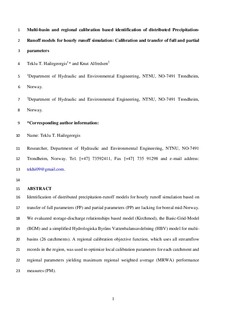Multi-basin and regional calibration based identification of distributed precipitation–runoff models for hourly runoff simulation: calibration and transfer of full and partial parameters
Journal article, Peer reviewed
Accepted version
Permanent lenke
http://hdl.handle.net/11250/2480576Utgivelsesdato
2016Metadata
Vis full innførselSamlinger
Sammendrag
Identification of distributed precipitation–runoff models for hourly runoff simulation based on transfer of full parameters (FP) and partial parameters (PP) are lacking for boreal mid-Norway. We evaluated storage–discharge relationships based model (Kirchmod), the Basic-Grid-Model (BGM) and a simplified Hydrologiska Byråns Vattenbalansavdelning (HBV) model for multi-basins (26 catchments). A regional calibration objective function, which uses all streamflow records in the region, was used to optimize local calibration parameters for each catchment and regional parameters yielding maximum regional weighted average (MRWA) performance measures (PM). Based on regional median Nash–Sutcliffe efficiency (NSE) and NSEln (for log-transformed series) for the calibration and validation periods, the Kirchmod model performed better than the others. Parsimony of the Kirchmod model provided less parameter uncertainty for the FP case but did not guarantee parameter identifiability. Tradeoffs between parsimony and performance were observed despite advantages of parsimony to reduce parameter correlations for the PP, which requires preliminary sensitivity analysis to identify which parameters to transfer. There are potential advantages of using the MRWA method for parameter transfer in space. However, temporal validation indicated marked deterioration of the PM. The tradeoffs between parameter transfers in space and time substantiate both spatial and temporal validation of the regional calibration methodology.
